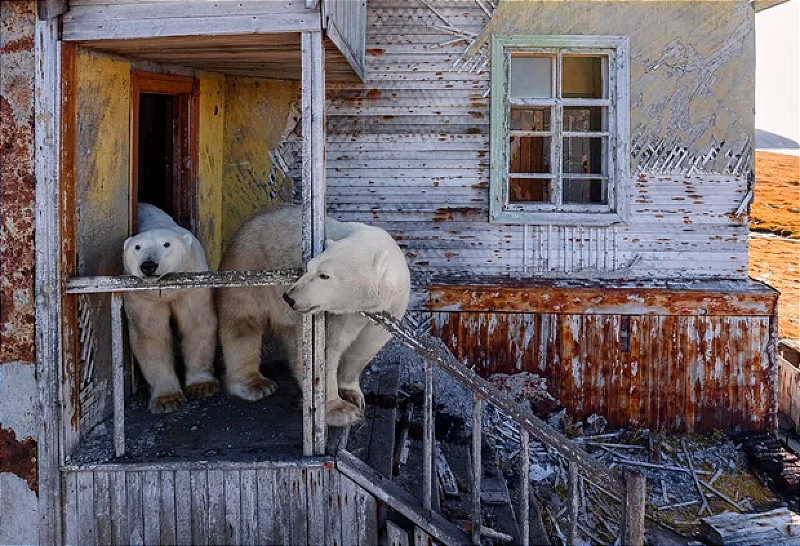Polar bears invade abandoned Soviet-era research station

Polar bears on an island off Russia's eastern coast have taken over an abandoned research station and made themselves at home. Drone footage captured by photographer Vadim Makhorov shows the large bears getting comfortable in the remains of a Soviet-era weather station on Kolyuchin Island. The tiny island is about seven miles from the coast of the Chukotka Peninsula, which faces Alaska and was abandoned in the 1990s, after the Soviet Union fell. Makhorov was using a drone to film the landscape of the island when he saw the bears, he said in a Facebook post. Photos show the bears inside homes, looking out windows and resting on porches. Makharov said that there were about 20 bears in the area, and one tried to catch the drone as it approached. (via Reuters)
A tiny art gallery in an old stairwell displays equally tiny works of art

In 2016, while artist McKay Lenker Bayer was still an undergraduate, her professor assigned the class the task of exhibiting their work. Unsure about presenting her work to the public, she downsized, quite literally, showing miniature paintings with teensy-tiny labels. In 2018, Lenker Bayer established Tiny Art Show, a community art project in Provo, Utah, to show original work by numerous artists. Until this year, the project was largely nomadic, but Tiny Art Show now has its own dedicated space. Installed at 1:6 scale, the storefront-style gallery sits inside what was originally a stairwell, accessible from street level. Its blue facade is reminiscent of retail spaces in New York City or London, and inside, it’s what Lenker Bayer describes as “a fully functional, commercial art gallery… that just happens to be tiny.” Original work is for sale, opening events draw gatherings of people who enjoy tiny snacks, and you can even grab a tiny newspaper from the vending machine near the door. (via Colossal)
Humans can smell the earth at parts per trillion like sharks can smell blood

In 1965, chemists Nancy Gerber and Hubert Lechevalier isolated and named what they called “geosmin” (meaning “earth smell”), having determined that it derived from a special genus of bacteria, Streptomyces, that live in the soil. Bacteria in the Streptomyces genus play an expansive and central role in decomposition. They break down complex organic matter, help to release nutrients into the soil, make other nutrients available for plant uptake, and produce a range of essential bioactive compounds, including antibiotics. Geosmin is just one byproduct of the life cycle of these bacteria, released simultaneously as they form spores for reproduction. Humans can detect geosmin at incredibly low levels—far lower than most other animals, as low as 100 parts per trillion. That’s better than sharks can smell blood in water. Centuries ago, it likely helped us locate safe drinking water and fertile land for crops. (via Why Is This Interesting)
Hi everyone! Mathew Ingram here. I am able to continue writing this newsletter in part because of your financial help and support, which you can do either through my Patreon or by upgrading your subscription to a monthly contribution. I enjoy gathering all of these links and sharing them with you, but it does take time, and your support makes it possible for me to do that. I also write a weekly newsletter of technology analysis called The Torment Nexus.
Chicago's famous rat-shaped hole in the pavement was likely made by a squirrel

It takes a special kind of misfortune to splat onto wet concrete, decay in anonymity, and go viral 20 years later. Such is the fate of the rodent that created what’s now known as the Chicago rat hole. Thought to have been formed in the early 2000s when a bird of prey dropped a brown rat, Chicagoans christened the site “splatatouille” and jokingly turned it into a shrine, leaving behind offerings such as Swiss cheese. Perhaps acorns would have been more appropriate. According to a study published today in Biology Letters, there’s a 98.67% chance the city’s most famous rat was actually a squirrel. Researchers gathered measurements from 50 museum specimens of each of Chicago’s eight rodent species, across sexes and a range of body sizes. They then statistically compared the museum data against the rat hole itself. (via Science.org)
Mercedes-Benz cars trick your ear to make an airbag going off seem quieter

The use of pyrotechnic gas generators to inflate airbags was the leap forward that made airbags practical and effective for use in automobiles. However, as you might imagine, releasing a massive burst of gas in under 50 milliseconds does create a rather large pressure wave—which we experience as an incredibly loud sound. If you ever seen airbags detonated outside of a vehicle, you’ve probably noticed they sound rather akin to fireworks or a gun going off. Mercedes-Benz developed a system to protect the hearing of vehicle occupants in the event that the airbags are fired. The trick is in using the body’s own reactions to sound to reduce damage to the ear. The stapedius reflex (also known as the acoustic reflex) is one of the body’s involuntary, instantaneous movements in response to an external stimulus—in this case, certain sound levels. Mercedes-Benz engineers realized that the stapedius reflex could be pre-emptively triggered ahead of firing the airbags, in order to provide a protective effect for the ears. (via Hackaday)
They turned a mushroom's bioelectric signals into music

Acknowledgements: I find a lot of these links myself, but I also get some from other newsletters that I rely on as "serendipity engines," such as The Morning News from Rosecrans Baldwin and Andrew Womack, Jodi Ettenberg's Curious About Everything, Dan Lewis's Now I Know, Robert Cottrell and Caroline Crampton's The Browser, Clive Thompson's Linkfest, Noah Brier and Colin Nagy's Why Is This Interesting, Maria Popova's The Marginalian, Sheehan Quirke AKA The Cultural Tutor, the Smithsonian magazine, and JSTOR Daily. If you come across something interesting that you think should be included here, please feel free to email me at mathew @ mathewingram dot com



